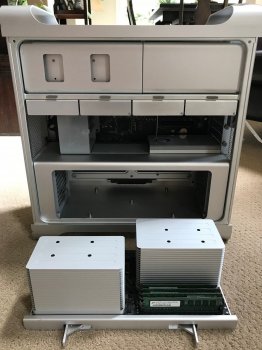We already know cMP itself is a bottlenck to very strong GPUs. Anything above GTX 960 / 280X level is overkill. We must see the platform's ability while benchmarking on a cMP, no? "How much of a bottleneck is a cMP for X GPU?" That's the question. We don't need to compare a 1080Ti to a Vega 64 for instance. Techpowerup has a great, in depth benchmark data, comparing an enormous amount of GPUs.
I observed that Valley benchmark shows a computer's general gaming performance. We can grab that information while benchmarking. Why ruin it?
Unigine set default medium settings for OpenGL on Mac, because achieving playable framerates is hard for higher settings, for any Mac.
Please observe CPU usage while benchmarking. CPU is not the only factor. PCIe speed, RAM speed, system bus speed, PSU, all comes into play. 1080Ti is an overpowered beast for a cMP. Certainly overkill.
It doesn't make sense at all. I observed this on a 1,1 and 3,1. Any card will get same (or scaringly close) OpenGL scores in Cinebench and War Thunder on Windows (not bootcamp, direct insall).
That's why it's an overkill, but don't forget the EFI factor. On my thread again, you can see GTX 1060 getting very bad results. I think it's because the lack of Apple EFI
Again, we don't have to measure the real GPU performance. There's always Techpowerup. We need to know what card can show its potential and what card can't. We need to know those two 6 pin powers are more than enough for us. We mustn't put power hungry beasts in cMPs.
When I look at those AND your 1080 Ti's results with W3690 (X5690) I see two things clearly:
1- A ceiling for cMP for max FPS, no matter what. Your 1080 Ti is ultra heavily bottlenecked.
2- Unflashed PC cards have a penalty, because a GTX 3 GB is faster than an R9 390 (I had both cards at the same time), but the results are clear. It loses on cMP.
What are you talking about, we are not measuring the GPU performance? Then what you want to say? What's the point of running Valley benchmark and you emphasis that's not CPU limiting (anyway, I already proved that it is)?
You said "I believe unflashed GPU's has a limitation. A 380X must have done much better. Here's what I get with a flashed 270X. Check minimum FPS please. Didn't overclock the card." It is not about GPU performance?
You only focus on the min FPS but ignore everything else. And I already show you that min FPS is not reliable in Valley benchmark because that can go very low during scenes transition. Guess what? I can get even lower min FPS in Valley with the lowest setting on my cMP (same OS, same W3690, same RX580)
What's that mean? It means this particular measurement is NOT reliable.
If we are not using Valley to measure the difference between GPU performance, then what we are doing here?
Also, tell me, why we need a playable frame rate for comparing performance. It's not gaming, just benchmark, I already gave you an example. 6FPS is 100% stronger than 3FPS, what's wrong with that? You made an assumption that we need "playable" for benchmarking, why? where it come from? What's the difference between "6FPS vs 3FPS" and "60FPS vs 30FPS"? numbers are just numbers, 100% stronger is 100% stronger. Going lower setting just make the test more easily become CPU limiting (not necessary the whole process, but lets say 10% of the time is CPU limiting, then the result already unable to accurately tell the difference in GPU performance).
I already show you the CPU usage in my last post, please show me yours.
Everything make sense, the lowest setting has roughly the same result as the med setting, because it's CPU limiting.
EFI is completely irrelevant to GPU performance. 1060 perform badly because the Nvidia web driver has much higher overhead than AMD driver in macOS. Please feel free to try that in Cinebench (you already know this is 100% CPU limiting benchmark), same result will be observe, again, because it's CPU limiting, and Nvidia GPU has higher overhead.
NO, you didn't show anything about Mac EFI has anything to do with performance on AMD card. Absolutely zero prove so far. (BTW, what is GTX 3GB? Where the R9 390 come from?)
If you want to prove that Mac EFI can significant affect the performance. Please do the following.
1) Install a AMD card that with the original PC VBIOS
2) Open Activity Monitor (to make sure CPU is not limiting during benchmark)
3) make sure there is nothing opened and the computer is quite idle
4) Run Valley benchmarks at highest setting (window mode, that will allow us to monitor CPU usage)
5) re-run Valley benchmarks 2 more times to make sure the results are consistent
6) Flash that AMD card with Mac EFI (the EFI ROM must be created by the original PC VBIOS)
7) re-do step 2-5 on the same cMP (with same spec, of course)
8) comparing the result
I had HD7950, R9 280, R9 380 before I moved to 1080Ti and RX580. I can tell there is absolutely no performance difference by just flashing the card (even resistor mod usually prove zero benefit as well). I didn't keep all the record, so, can't show you. But please prove me wrong. I am more than happy to learn. I am more than happy to be corrected. But I need some reliable evidences to show me that an AMD GPU performance can be significantly improved by adding the Mac EFI.
Please, make it happen. Just keep focus on the min FPS on a particular benchmark won't help to solve this problem.











